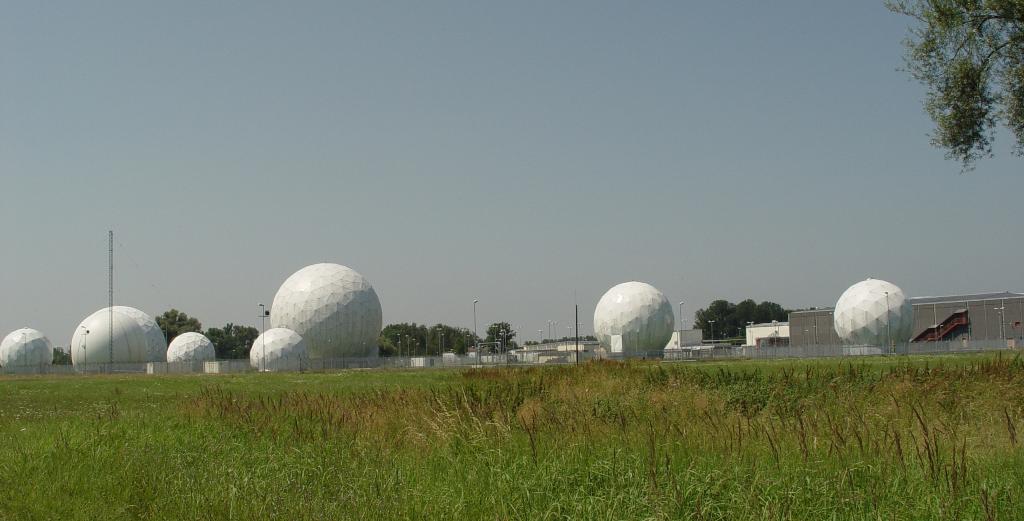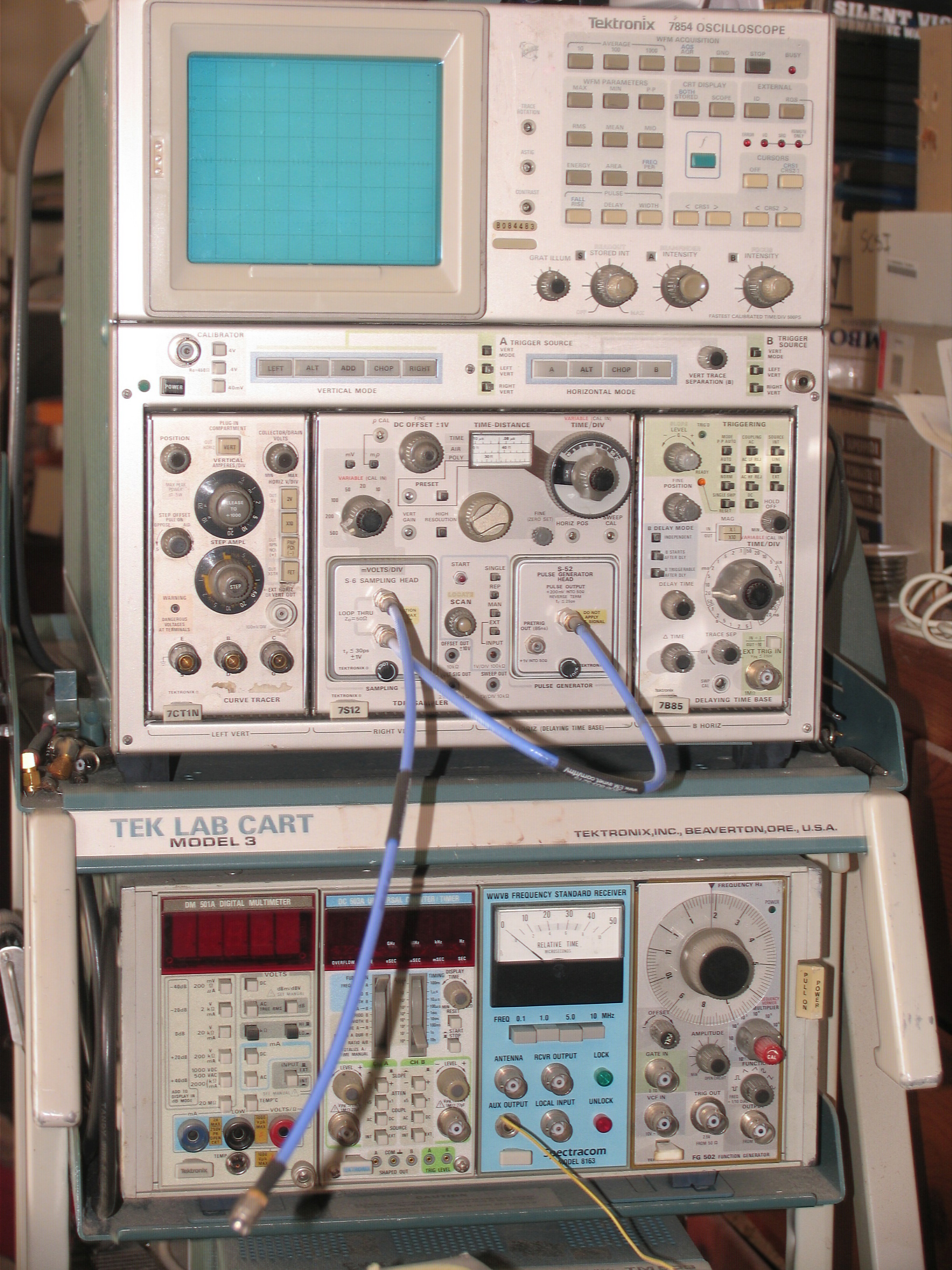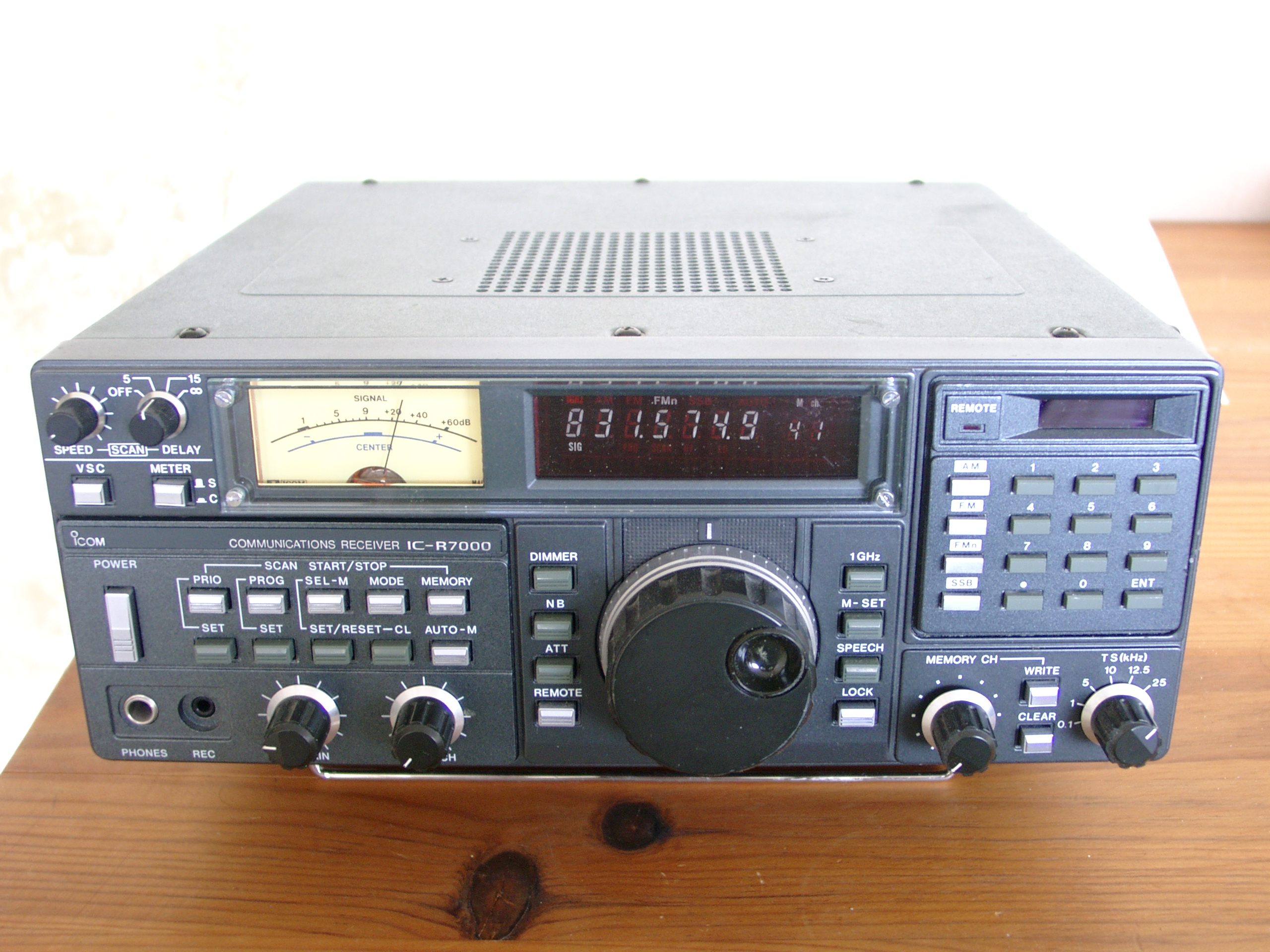|
Measuring Receiver
In telecommunication, a measuring receiver or measurement receiver is a calibrated laboratory-grade radio receiver designed to measure the characteristics of radio signals. The parameters of such receivers (tuning frequency, receiving bandwidth, gain) can be adjusted over a much more comprehensive range of values than other radio receivers. Their circuitry is optimized for stability and enables calibration and reproducible results. Some measurement receivers also have exceptionally robust input circuits that can survive brief impulses of more than 1000 V, as they can occur during measurements of radio signals on power lines and other conductors. Applications Measuring receivers are used with calibrated antennas to: * determine the signal strength and standard compliance of broadcast signals; * investigate and quantify radio-frequency interference, and * determine compliance of a device with electromagnetic interference and TEMPEST standards and regulations. Measuring receivers ... [...More Info...] [...Related Items...] OR: [Wikipedia] [Google] [Baidu] |
Telecommunication
Telecommunication, often used in its plural form or abbreviated as telecom, is the transmission of information over a distance using electronic means, typically through cables, radio waves, or other communication technologies. These means of transmission may be divided into communication channels for multiplexing, allowing for a single medium to transmit several concurrent Session (computer science), communication sessions. Long-distance technologies invented during the 20th and 21st centuries generally use electric power, and include the electrical telegraph, telegraph, telephone, television, and radio. Early telecommunication networks used metal wires as the medium for transmitting signals. These networks were used for telegraphy and telephony for many decades. In the first decade of the 20th century, a revolution in wireless communication began with breakthroughs including those made in radio communications by Guglielmo Marconi, who won the 1909 Nobel Prize in Physics. Othe ... [...More Info...] [...Related Items...] OR: [Wikipedia] [Google] [Baidu] |
Rohde & Schwarz
Rohde & Schwarz GmbH & Co. KG ( , ) is a German multinational electronics group specializing in the fields of electronic test equipment, broadcast & media, cybersecurity, radiomonitoring and radiolocation, and radiocommunication. The company also provides products for wireless communications, the electronics industry, aerospace and defense, homeland security and critical infrastructures. In addition to the Munich headquarters, there are regional headquarters in the United States (Columbia, Maryland) and in Asia (Singapore). Worldwide the company has a total of about 14,400 employees in over 70 countries. History PTE and World War 2 The company was founded by :de:Lothar Rohde, Lothar Rohde and :de:Hermann Schwarz (Industrieller), Hermann Schwarz who met while studying physics in Jena. They built their first T&M instrument in 1932, and in August 1933, the ''Physikalisch-Technisches Entwicklungslabor Dr. Rohde & Dr. Schwarz'' (known as ''PTE'') started in business. Ceramic i ... [...More Info...] [...Related Items...] OR: [Wikipedia] [Google] [Baidu] |
Electronic Test Equipment
Electronic test equipment is used to create signals and capture responses from electronic devices under test (DUTs). In this way, the proper operation of the DUT can be proven or faults in the device can be traced. Use of electronic test equipment is essential to any serious work on electronics systems. Practical electronics engineering and assembly requires the use of many different kinds of electronic test equipment ranging from the very simple and inexpensive (such as a test light consisting of just a light bulb and a test lead) to extremely complex and sophisticated such as automatic test equipment (ATE). ATE often includes many of these instruments in real and simulated forms. Generally, more advanced test gear is necessary when developing circuits and systems than is needed when doing production testing or when troubleshooting existing production units in the field. Types of test equipment Basic equipment The following items are used for basic measurement of voltages, c ... [...More Info...] [...Related Items...] OR: [Wikipedia] [Google] [Baidu] |
Network Analyzer (electrical)
A network analyzer is an instrument that measures the Two-port network, network parameters of electrical networks. Today, network analyzers commonly measure scattering parameters, s–parameters because Signal reflection, reflection and Transmission line, transmission of electrical networks are easy to measure at high frequencies, but there are other network parameter sets such as y-parameters, z-parameters, and Two-port network#Hybrid parameters (h-parameters), h-parameters. Network analyzers are often used to characterize two-port networks such as amplifiers and filters, but they can be used on networks with an arbitrary number of Port (circuit theory), ports. Overview Network analyzers are used mostly at high frequency, frequencies; operating frequencies can range from 1 Hz to 1.5 THz. Special types of network analyzers can also cover lower frequency ranges down to 1 Hz. These network analyzers can be used, for example, for the stability analysis of open loo ... [...More Info...] [...Related Items...] OR: [Wikipedia] [Google] [Baidu] |
Agilent
Agilent Technologies, Inc. is an American global company headquartered in Santa Clara, California, that provides instruments, software, services, and consumables for laboratories. Agilent was established in 1999 as a spin-off from Hewlett-Packard. The resulting IPO of Agilent stock was the largest in the history of Silicon Valley at the time. From 1999 to 2014, the company produced optics (LED, laser), semiconductors, EDA software and test and measurement equipment for electronics; that division was spun off to form Keysight. Since then, the company has continued to expand into pharmaceutical, diagnostics & clinical, and academia & government (research) markets. Products and services Agilent serves analytical laboratories and the clinical and routine diagnostics markets with a full suite of technology platforms. These include: automation, bioreagents, FISH probes, gas and liquid chromatography, immunohistochemistry, informatics, mass spectrometry, microarrays, spectroscopy, ... [...More Info...] [...Related Items...] OR: [Wikipedia] [Google] [Baidu] |
Noise Figure
Noise figure (NF) and noise factor (''F'') are figures of merit that indicate degradation of the signal-to-noise ratio (SNR) that is caused by components in a signal chain. These figures of merit are used to evaluate the performance of an amplifier or a radio receiver, with lower values indicating better performance. The noise factor is defined as the ratio of the output noise power of a device to the portion thereof attributable to thermal noise in the input termination at standard noise temperature ''T''0 (usually 290 K). The noise factor is thus the ratio of actual output noise to that which would remain if the device itself did not introduce noise, which is equivalent to the ratio of input SNR to output SNR. The noise ''factor'' and noise ''figure'' are related, with the former being a unitless ratio and the latter being the logarithm of the noise factor, expressed in units of decibels (dB). General The noise figure is the difference in decibel (dB) between the noise ... [...More Info...] [...Related Items...] OR: [Wikipedia] [Google] [Baidu] |
Sensitivity (radio Receiver)
The sensitivity of an electronic device, such as a communications system receiver, or detection device, such as a PIN diode, is the minimum magnitude of input signal required to produce a specified output signal having a specified signal-to-noise ratio, or other specified criteria. In general, it is the signal level required for a particular quality of received information. In signal processing, sensitivity also relates to bandwidth and noise floor as is explained in more detail below. In the field of electronics different definitions are used for sensitivity. The IEEE dictionary states: "Definitions of sensitivity fall into two contrasting categories." It also provides multiple definitions relevant to sensors among which 1: "(measuring devices) The ratio of the magnitude of its response to the magnitude of the quantity measured.” and 2: "(radio receiver or similar device) Taken as the minimum input signal required to produce a specified output signal having a specified ... [...More Info...] [...Related Items...] OR: [Wikipedia] [Google] [Baidu] |
Hertz
The hertz (symbol: Hz) is the unit of frequency in the International System of Units (SI), often described as being equivalent to one event (or Cycle per second, cycle) per second. The hertz is an SI derived unit whose formal expression in terms of SI base units is 1/s or s−1, meaning that one hertz is one per second or the Inverse second, reciprocal of one second. It is used only in the case of periodic events. It is named after Heinrich Hertz, Heinrich Rudolf Hertz (1857–1894), the first person to provide conclusive proof of the existence of electromagnetic waves. For high frequencies, the unit is commonly expressed in metric prefix, multiples: kilohertz (kHz), megahertz (MHz), gigahertz (GHz), terahertz (THz). Some of the unit's most common uses are in the description of periodic waveforms and musical tones, particularly those used in radio- and audio-related applications. It is also used to describe the clock speeds at which computers and other electronics are driven. T ... [...More Info...] [...Related Items...] OR: [Wikipedia] [Google] [Baidu] |
Preferred Number
In industrial design, preferred numbers (also called preferred values or preferred series) are standard guidelines for choosing exact product dimensions within a given set of constraints. Product developers must choose numerous lengths, distances, diameters, volumes, and other characteristic quantities. While all of these choices are constrained by considerations of functionality, usability, compatibility, safety or cost, there usually remains considerable leeway in the ''exact'' choice for many dimensions. Preferred numbers serve two purposes: # Using them increases the probability of compatibility between objects designed at different times by different people. In other words, it is one tactic among many in standardization, whether within a company or within an industry, and it is usually desirable in industrial contexts (unless the goal is vendor lock-in or planned obsolescence) # They are chosen such that when a product is manufactured in many different sizes, these will end ... [...More Info...] [...Related Items...] OR: [Wikipedia] [Google] [Baidu] |
DO-160
DO-160, Environmental Conditions and Test Procedures for Airborne Equipment is a standard for the environmental testing of avionics hardware. It is published by the Radio Technical Commission for Aeronautics (RTCA) and supersedes DO-138. Outline of contents Introduction The DO-160 document was first published on February 28, 1975 to specify test conditions for the design of avionics electronic hardware in airborne systems. Since then the standard has undergone subsequent revisions up through Revision G. Purpose This document outlines a set of minimal standard environmental test conditions (categories) and corresponding test procedures for airborne equipment for the entire spectrum of aircraft from light general aviation aircraft and helicopters through the jumbo jets and supersonic transport categories of aircraft. The purpose of these tests is to provide a controlled (laboratory) means of assuring the performance characteristics of airborne equipment in environmental condit ... [...More Info...] [...Related Items...] OR: [Wikipedia] [Google] [Baidu] |
MIL-STD 461
MIL-STD-461 is a United States Military Standard A United States defense standard, often called a military standard, "MIL-STD", "MIL-SPEC", or (informally) "MilSpecs", is used to help achieve standardization objectives by the United States Department of Defense. Standardization is beneficial ... that describes how to test equipment for electromagnetic compatibility. The United States Department of Defense issued MIL-STD-461 in 1967 to integrate electromagnetic compatibility into the research and development stage for defense communications technology. Various revisions of MIL-STD-461 have been released. Many military contracts require compliance to MIL-STD-461E. The latest revision (as of 2015) is known as "MIL-STD-461G". While MIL-STD-461 compliance is technically not required outside the US military, many civilian organizations also use this document. In 1999, MIL-STD-462 was combined with MIL-STD-461D into MIL-STD-461E. [...More Info...] [...Related Items...] OR: [Wikipedia] [Google] [Baidu] |
Radio Receiver
In radio communications, a radio receiver, also known as a receiver, a wireless, or simply a radio, is an electronic device that receives radio waves and converts the information carried by them to a usable form. It is used with an antenna. The antenna intercepts radio waves (electromagnetic waves of radio frequency) and converts them to tiny alternating currents which are applied to the receiver, and the receiver extracts the desired information. The receiver uses electronic filters to separate the desired radio frequency signal from all the other signals picked up by the antenna, an electronic amplifier to increase the power of the signal for further processing, and finally recovers the desired information through demodulation. Radio receivers are essential components of all systems based on radio technology. The information produced by the receiver may be in the form of sound, video (television), or digital data. A radio receiver may be a separate piece of electronic equ ... [...More Info...] [...Related Items...] OR: [Wikipedia] [Google] [Baidu] |






